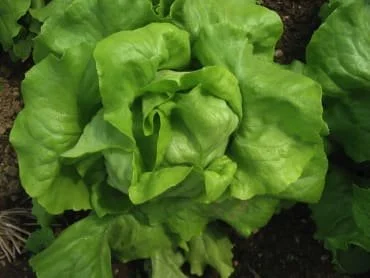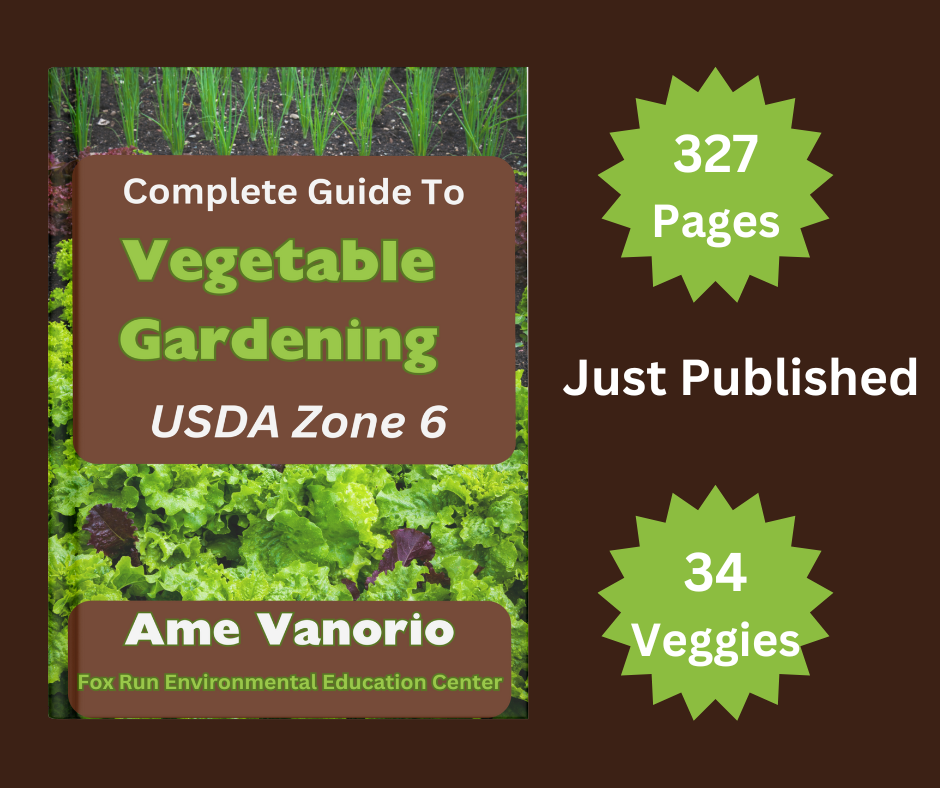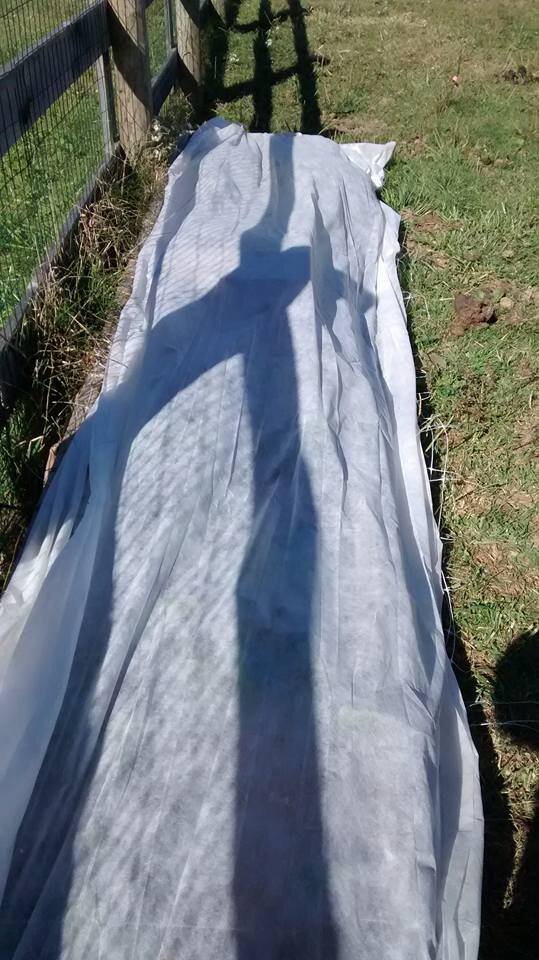Lettuce is a mainstay in the American diet. Fresh salads, sandwich ingredients, and as a garnish, lettuce adds fiber and nutrients to our diets.
We are blessed in Zone 6B to get a solid three seasons with our lettuce crops. In fact, I have grown lettuce outside from March to December.
Fun Fact: Lettuce is part of the daisy family!
Types of Lettuce
There are several different types of lettuce. It’s important to learn about the different types because they have different growing needs and will perform slightly differently.
Butterhead
Also called Boston or Bibb lettuce forms a loosehead and is a mix of head lettuce and a leaf. It has a sweet flavor with a crunchy texture. They are often slower to bolt and many cultivars do well in summer.
Takes 65 - 80 days to mature.
Nancy, a Butterhead variety from Fedco.
Iceberg/Crisphead
Very popular with commercial growers and sales to grocery stores and restaurants. My opinion is Yuch. Don’t bother, there are so many other lettuce varieties that hold up better in the field and taste delicious. Iceberg lettuce is boring (my unfiltered opinion)
Leaf Lettuce
Comes in green, red, and mixed colors and is also known as looseleaf, cutting, or bunching lettuce. Great for home gardeners because it is easy to grow and adapts well to a variety of conditions. It is referred to as “cut and come again crop” because you can harvest single leaves and more will keep growing.
Mild flavor comes in a variety of textures and leaf shapes. It’s quite fun to grow several varieties and mix them together in a salad.
Typically takes 40-50 days till maturity but you can start harvesting at 21 days.
Romaine/Cos
This variety grows compact and tall in upright heads. The variety is often found in Cesear Salad. First grown in the Mediterranean region 5,000 years ago.
The longest to mature at about 80 days. Best to start indoors and transplant. Varieties will differ on heat tolerance so read the descriptions.
Summercrisp/Batavian
Summercrisp lettuce is a combination of a crisphead and leaf variety. They are slow to bolt so many of them are good for summer growing and flavorful.
Varieties - My Favorites
There are literally approximately 1100 named lettuce varieties. The seed is inexpensive so try several varieties each season to see what grows best for you.
Below are my tried and true favorites. I love experimenting with lettuce so it was hard to choose!
Butterhead
Nancy - Nancy is my favorite because the outer leaves are flexible yet firm enough to make good wraps for things like egg salad sans bread.
Nice buttery flavor. Matures in 58 days.
Winter Marvel - great variety for fall and wintering over. Hates heat. I had it bolt in a greenhouse in late fall. Holds well under row cover in winter. I’ve had it looking great in December - it just got eaten before we could see how it handles January!
Leaf Lettuce
Black Seeded Simpson - this is my favorite leaf lettuce (ad). While it is not as flashy it is a very consistent grower. It never fails to germinate, grows quickly, and avoids most pests.
Reliable. Fast grower. 46 Days to full size, 28 days for baby.
Red Sails - beautiful lettuce with deep maroon coloring and ruffled leaves. 55 days to full maturity. 30 days for baby leaf. Use thinnings in salads.
Leaf Lettuce Mixes
Lettuce mixes for leaf lettuce are quite popular and I like them a lot. It’s fun to plant a row and have it come up with a variety of colors and textures.
Two of my favorites are Allstar Gourmet Mix from Johnnys and DeLux Lettuce Mix from Fedco’s.
All Star Gormet Mix From Johnny’s Select Seed is one I grow every year.
Romaine
Jericho - Bred in Isreal and will tolerate summer heat when well-watered- although it can be susceptible to mold. So give it wide spacing of twelve inches so that it gets good air circulation.
60 Days to maturity.
Thurnius - a red Romaine with great heat tolerance. Disease resistant. 56 Days to maturity.
Summer Crisp
Nevada is my favorite crisp. It holds up well in the heat, especially with shade cloth. Bright green leaves with a nice mild flavor.
Planting
Lettuce likes to grow fast so make sure you have a growing bed prepared. Mix in lots of compost to add nutrients and maintain moisture consistency.
Most lettuce prefers a cool growing temperature between 60 - 70 degrees Fahrenheit. So spring and fall will be your biggest planting times.
Lettuce is a wonderful crop for succession planting. Plant every two weeks right up to September or October. That way you have a consistent supply. You don’t have to plant a lot.
Check out my article My Planting Schedule Zone 6B
Starting Seeds
I start seeds inside around March 1st because I’m impatient to get started. Lettuce actually likes a cool starting temperature, unlike many garden species. I am also monitoring the greenhouse night temps and will direct seed in the greenhouse in mid-March.
For planting in pots or trays use a light seedling soil with peat moss and perlite mixed in. Plant very shallow about 1/4 of an inch deep. I typically make a small indentation with the eraser side of a pencil, place the seed in the indentation and sprinkle some soil on top.
Lettuce likes bottom water so I typically set the seed tray (with holes) in a larger tray (no holes ) and let it soak up water.
No fertilizer is needed at this stage.
Direct seeding
I begin to direct seed outdoors in mid-April depending on weather patterns. Lettuce seedlings can handle a light frost if you have them covered with garden fabric. The minimum soil temperature should be about 40 degrees and you can help that along by applying some black landscaping fabric in late March.
Once your nighttime temperatures start to moderate you can plant outside undercover. I like to start leaf lettuce seeds in a raised bed with some onion sets, spinach, and arugula to make a nice salad.
Seeds will germinate down to 40 degrees but more slowly.
Plant lettuce anywhere from 4-10 inches apart. Leaf lettuces can be planted closer and butter crisps need more room.
Ame’s Easy Leaf Lettuce Planting Method
Water the soil so that it is moist.
Take a butter knife and make a very shallow trench about 1/4 inch deep.
Sprinkle the seeds carefully in the trench and smooth the soil over them.
Pat the soil with your hand so it’s firmly against the seeds.
Your seeds are going to germinate and be too close together. However, you can just thin them and eat the thinnings for dinner. I like to plant lettuce mixes this way as its a fun colorful instant salad.
I get a lot of questions about self-sufficiency in small spaces. Here's an example of a spring/cool weather raised bed garden. This picture was taken on April 13 a couple of years ago. So this raised bed is 2X12 feet and 10 inches deep. It's filled with compost and bio comp. And has hoops with garden fabric in case we get some chilly weather. It held 3 cabbages, 4 broccoli, 4 Swiss chard, 4 lacitino kale, 2 red Russian kale, 2 arugulas, 3 lettuce, and 6 onions. Because it was a pretty close nit group of plants I did fertilize it every two weeks with fish emulsion.
Caring
Fertilizing
If you have a bed prepared that has lots of compost and maybe some added calcium mixed in then you may not need to fertilize.
I do fertilize lettuce because it grows quickly and a good organic liquid fertilizer (ad) will give it a boost.
I give a half-strength dose during transplanting or when they are about 4 inches tall.
I fertilize leaf lettuce after I’ve harvested to help it recover and Romaine about a week before harvesting.
You can check out my Resource Page to see my favorite garden supplies.
Mulch
There are pros and cons to mulching lettuce. You will have to think about what’s most beneficial for you.
Pros
Helps keep the soil moist
Keeps soil temperatures cooler
Cons
Mulch makes a nice environment for bugs, slugs, and snails all of which want to munch on your lettuce
Watering
Lettuce likes moist soil and it has shallow roots. This means frequent watering. Especially in summer.
However, overhead watering is a no-no because lettuce is prone to fungal issues, especially in Zone 6B. Use drip irrigation or water carefully at the ground level.
What you don’t want is any soil splashing onto the undersides of the lettuce leaves.
Weeding
Weeds can out-compete lettuce quickly. So weed your lettuce bed frequently.
However, you want to be careful weeding lettuce because 1. the lettuce may look like a weed, and 2. You can disrupt the lettuce’s roots when pulling up weeds. So make sure you give their bed a good weeding before you plant.
Subscribe to my YouTube Channel
Problems
Bacterial Leaf Spot
Bacterial leaf spot is a bacteria that shows up as brown or black spots on the leaves. The bacteria live in the soil and typically get on your plant via water.
This may happen if you are watering overhead or there is a heavy rainstorm. Both of which can splatter soil onto the leaves.
There is no cure so prevention is the best way to manage bacterial leaf spot.
Water from underneath or use irrigation.
Give space between plants so the mature leaves don’t touch.
Use landscaping fabric so you don’t have the soil splattering on the plants.
Bolting
Bolting is not a disease but a natural response to warm temperatures. It becomes a management challenge in the summer months.
Bolting typically happens when the high daytime temperature gets over 75 degrees.
When temperatures rise and the days get longer the lettuce plant responds by bolting. They do this as a precursor to forming seed pods. So if you want seeds you can allow this to happen.
Ways to prevent bolting:
Plant varieties that do better in summer
Use shade cloth
Plant in an area that gets morning sun and afternoon shade
Lettuce or Bottom Rot
Lettuce Rot and Bottom Rot are caused by the soil-borne fungus Rhizoctonia solani. It is a problem in humid areas of Zone 6 as well as in greenhouse culture. The pathogen favors temperatures between 75 - 85 degrees Fahrenheit.
Bottom rot affects several species of plants such as endive, radish, and cucumbers. It can overwinter in your garden and is most common in head and Romaine varieties.
Ways to avoid lettuce rot:
Make sure you have well-drained soil.
Lettuce needs nutrient-rich soil to grow quickly and avoid diseases
Test your soil - lettuce may benefit from added calcium.
Plant in a location that gets good air circulation; use fans in greenhouses
Clean and disinfect growing surfaces and containers
Wildlife
Wildlife loves lettuce just as much as your livestock! I have several articles under the wildlife tab and they always include ways you can keep them out of the garden.
Wildlife such as white-tailed deer, rabbits, and groundhogs love fresh lettuce leaves.
Snails and Slugs
Snails, slugs, and cabbage loppers are also pests that will eat lettuce. Sluggo (ad) is a good organic repellent that kills snails and slugs but is safe for pets and wildlife.
You can also do the classic of filling a shallow dish with beer and placing it so the rim is even with the soil level. Snails and slugs are attracted and climb in for a fatal drink.
Companion Planting
To protect your lettuce plant it among plants in the mint family and marigolds that repel slugs and cabbage loppers.
Adding lettuce into a Three-Sisters garden or at the base of trellised squashes and cucumbers helps to give them much-needed summer shade.
I like to plant a salad garden. Lettuce will mix well with onions, radishes, arugula, and spinach.
Avoid planting lettuce with members of the brassica or the mustard family.
Harvesting and Storing
Leaf, butterhead, and romaine types can be harvested by removing the outer leaves, pulling up the whole plant, or cutting the plant about an inch above the soil surface.
Harvest in the morning when the plant is cool.
Store in refrigerator for up to ten days.
Saving Seeds
Lettuce seeds are easy to gather and save. Make sure you save from open-pollinated varieties.
Allow your lettuce plant to bolt when warm weather sets in. They will look like gangly long-legged teens.
The lettuce sends up a stalk which will produce a small flower. Hopefully, you are encouraging pollinators to your garden. After pollination, the flowers will form seeds.
Lettuce seeds burst off the mother plant when ready. So cover the stalk with a paper bag and tie shut. You can also shake the plant each day and have the seeds drop into a dish.
It will take up to a week before all the seeds have reached the point of being ready to release themselves.
On a side note. You won’t want to eat any lettuce you allow to bolt. The leaves will become quite bitter.
Isolation
If you are letting several varieties of lettuce go to seed then you need to consider cross-pollination. Keep lettuce cultivars at least 25 feet from each other.
Cooking
Do you think lettuce is boring? Only good for salads and sandwiches?
Here are some fun ways to eat lettuce!
You can sear them or add them to a stir-fry.
Great way to add some fiber to your smoothie.
Lettuce wraps - no bread required. Use a firm leaf of lettuce and wrap it around meatballs, falafels, or taco filling. See the video below for some fabulous ideas.
Conclusion
Lettuce is an easy, fun crop to grow with endless cultivars to try. It makes a great children’s garden plant.
Author, Ame Vanorio, is the founder of Fox Run EEC, and loves to grow lettuce. Check out her Author Page on Amazon.










According to the EPA, the average medium size dog creates 274 pounds (125 kg) of waste each year. That’s a lot of poop!. Your backyard may be a minefield of dog manure and you don’t know what to do!